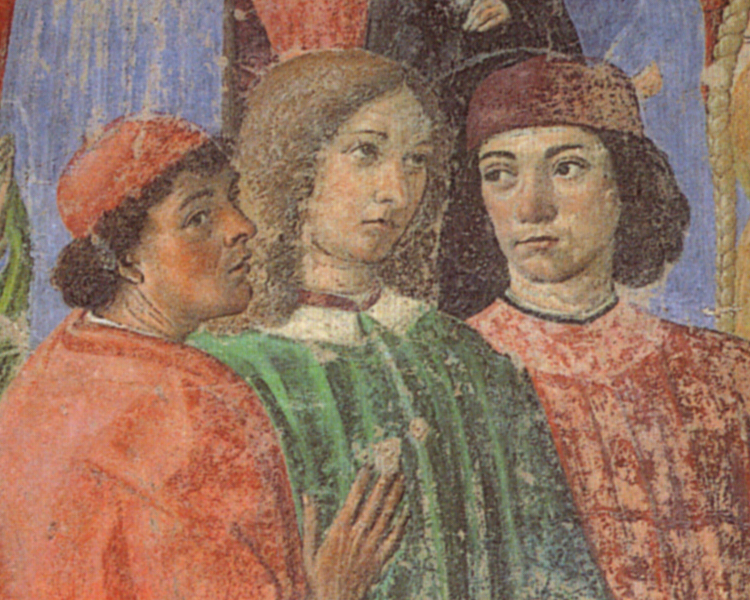Syncretism in the West

Updated 16 Nov 2009
This site provides an overview of S.A. [Stephen A.; ‘Steve’ in more recent writings] Farmer, Syncretism in the West: Pico’s 900 Theses (1486): The Evolution of Traditional Religious and Philosophical Systems (Tempe, Arizona: MRTS, 1998), 598 pages.
- Syncretism in the West can be purchased from Amazon and most other major booksellers (for about $32).
- Proofreading errors in the first edition are listed on the Errata Page [these errors were supposed to be all corrected by the publisher in the second printing but weren’t].
Files from key sections of the book, along with files of closely related theoretical work involving studies of ancient India and comparative history, can be downloaded from links found below.
Syncretism in the West develops a cross-cultural model of the evolution of premodern religious, philosophical, and cosmological thought, viewed through the exaggerated syncretic system developed in Pico’s 900 theses. Pico planned to debate the theses at Rome before the Pope and leaders of “all schools.” The book contains a corrected Latin edition of Pico’s text, the first English translation (the only reliable translation in any language), and a commentary on Pico’s debate, in which he planned to discuss (and partially harmonize) all major traditions known in his day.
(Pico literally had “cosmic ambitions”: in his letters and early texts, he hinted that debate of the 900 theses (the first printed book ever universally banned by the Church) might trigger Christ’s Second Coming and the end of the world; for evidence, see pp. 39-46 and passim in Syncretism in the West. You can download those pages here as a 1.3 meg pdf)
The cross-cultural model developed through study of the 900 theses discusses the neurobiological grounds of primitive religious thought and the systematic ways in which that thought was transformed by writers like Pico over thousands of years in manuscript traditions. One novel aspect of that model is its ability to be implemented in a series of simple computer simulations — the first of their type used to model the evolution of premodern thought. The simulations mimic the ways that syncretic processes operated in manuscript traditions, generating the kinds of multileveled ‘correlative’ (or fractal) structures typical world-wide of traditional religious, philosophical, and cosmological systems. Papers that discuss the research and teaching applications of the model can be downloaded from links provided below.
A few historical findings that have emerged since the book was published are covered in the following:
Pico contra Ficino: On Ficino’s Translation of Plotinus (webpage)
On the So-Called Oration ‘On the Dignity of Man’ (webpage). This famous title was not Pico’s and badly misrepresents the nature of his text, which provides a formal defense of philosophy meant to open his debate. (For discussion, see Syncretism in the West, pp. 32-4.) On the so-called freedom-of-will issue, see the extract below (“Pico and Freedom of the Will?”).
A few selections from Syncretism in the West are currently available as pdf files:
- Table of Contents and Preface (1.5 meg pdf)
- Pico’s debate: Preparing the way for the End of the World? (1.3 meg pdf.) Pico left some strong hints at least that that was his original plan. The textual evidence is discussed here.
- Pico and Renaissance Magic (overturns Frances Yates’s famous model of the origins of Renaissance magic in Pico and Ficino; Pico again emerges as Ficino’s adversary, not as his ‘disciple’; 3.5 meg pdf)
- Pico and ‘Freedom of the Will’? (1.7 meg pdf). The old view that Pico was a strong proponent of the so-called freedom of the will first arose from modernizing readings of the mistitled Oration ‘On the Dignity of Man‘ (on Pico’s own title, click here) by idealist historians in the late 19th and early 20th centuries. This section of the book discusses the complexities of Pico’s views of the ‘will’ and shows how distant those views were from the modern concepts with which they have been confused (especially by historians in the neo-Burckhardtian tradition, including Gentile, Semprini, Cassirer, Garin, Kristeller, Yates, Rice, Trinkaus, and many others). Standard textbook accounts of Pico’s thought have much to do with romantic fantasies about ‘human freedom’ and the ‘Renaissance philosophy of man’ that were popular in the dismal days just before and after World War II – but very little to do with Pico’s own views. (Those fantasies have had a long life due to the many reprints of translations of the so-called Oration ‘On the Dignity of Man‘ in anthologies produced in that period.)
- Charts of the 900 Theses. Provides an overview of the ‘authorities’ that Pico meant to discuss (and partially reconcile) in the 900 theses (550 k pdf). (Pico claimed that the debate would deal with “all the most ambiguous and controversial questions” of his time.)
- Theoretical Conclusions (1.2 meg pdf, pp. 91-6 from Syncretism in the West) that link syncretic processes, neurobiology, manuscript traditions, and the evolution of the ‘correlative’ structures typical cross-culturally of premodern religious, philosophical, and cosmological systems.
A biography (in French) of Pico’s nephew-editor Gianfrancesco Pico, an extreme anti-syncretist who collaborated (with Girolamo Savonarola) in the posthumous doctoring of Pico’s works, has been published as Steve Farmer and Steven Vanden Broecke, Jean-Francois Pic de la Mirandole (c. 1470-1533), in Centuriae latinae II. Cent une figures humanistes de la Renaissance (Geneva, 2006). We originally wrote the paper in 2000: so it goes with academic publishers.
I have an informal English translation of this biography that I will eventually publish; email me if you want a PDF.
Papers available below apply the model that originally arose from study of Pico to developments in premodern Chinese, Indian, and other non-Western traditions, which were driven by syncretic processes similar to those found in Pico’s work. The extreme nature of Pico’s 900 theses is what makes his work an ideal ‘laboratory’ to study the effects of syncretic processes in premodern traditions.
My main collaborators in my cross-cultural studies are Michael Witzel (Wales Professor of Sanskrit and Indian Studies, Harvard University), John B. Henderson (Chinese and East Asian Studies, Louisiana State University), Richard Sproat (Computational Linguistics, Oregon Health and Science University), Dorian Fuller (Archaeology and Ethnobiology, University College London), Steve Weber (Archaeology and Ethnobiology, Washington State University at Vancouver), and Bill Zaumen, Ph.D. (our lead programmer at the new Cultural Modeling Research Group and an MIT-trained physicist). PDF files on this part of our work can be downloaded from Article downloads.
Articles and lectures that demonstrate that the famous “undeciphered script” from the Indus Valley Civilization (or Harappa) was not part of a true writing or speech-encoding system, as had been assumed since the 1870s, are also available at Article downloads. Oddly, the first hints that the Indus Valley was not a literate civilization arose unexpectedly from the theoretical model first developed from study of Pico’s 900 theses.
For the most comprehensive overview of the evidence, see Steve Farmer, Richard Sproat, and Michael Witzel, The Collapse of the Indus-Script Thesis: The Myth of a Literate Harappan Civilization. Electronic Journal of Vedic Studies (EJVS): 11-2 (13 December 2004): 19-57. On the international controversy that article has spawned in studies of ancient India, which has a nasty modern political dimension, see Article downloads.
The fact that studies of a fifteenth-century CE Western intellectual like Pico could trigger a scientific controversy involving India’s oldest civilization (c. 2600 – 1900 BCE) demonstrates the power that theoretical models can currently bring to studies of the history of thought. Many signs indicate that we are moving into a scientific era of history far removed from the purely “descriptive” or “narrative” studies of the past. A detailed discussion is found in a book in progress (Brains and history: Modeling the evolution of human thought, from prehistory to the future [working title only]. For a description of this book and related papers, go to Article downloads.
Feb 2023 format changes from web server migration.
